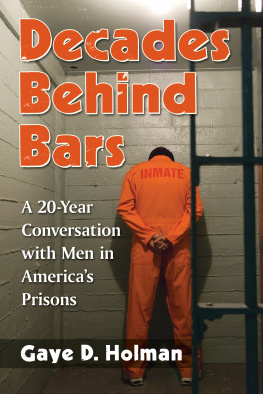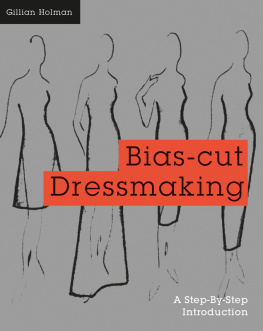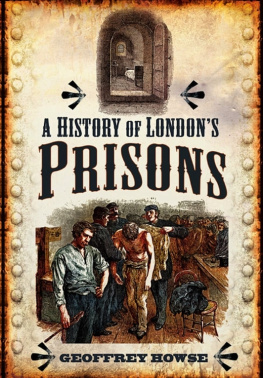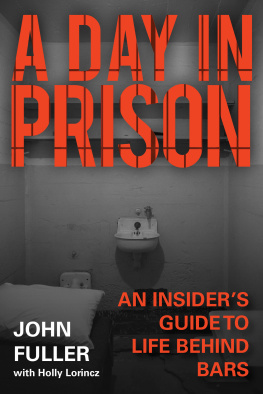
Decades Behind Bars
A 20-Year Conversation with Men in Americas Prisons
GAYE D. HOLMAN

McFarland & Company, Inc., Publishers
Jefferson, North Carolina
LIBRARY OF CONGRESS CATALOGUING DATA ARE AVAILABLE
BRITISH LIBRARY CATALOGUING DATA ARE AVAILABLE
e-ISBN: 978-1-4766-2848-6
2017 Gaye D. Holman. All rights reserved
No part of this book may be reproduced or transmitted in any form or by any means, electronic or mechanical, including photocopying or recording, or by any information storage and retrieval system, without permission in writing from the publisher.
Front cover image 2017 iStock
McFarland & Company, Inc., Publishers
Box 611, Jefferson, North Carolina 28640
www.mcfarlandpub.com
Acknowledgments
I owe much to many in the writing of this book. My completion of the manuscript is due in large part to the consistent support and encouragement of my three talented, diverse friends who are members of my valued writing group. They kept me on task, held me up when I was drowning in doubt and plied me with laughter. Susan Lindseys professional editing skills add immeasurably to the books clarity. Her patience, organization, and extraordinary knowledge of both words and computers saved me from overwhelming embarrassment and frustration. Katie Bush, one of the readers of the final draft, helped me forge a better narrative with her keen insights and probing questions. She helped balance my perspective with her well-timed humor. Bobbie Bryant served as a worthy model with her constant energy, dedication, and thoughtfulness, and she inspired me by completing three books of her own.
I also owe a great deal of appreciation to both Larry Chandler and Dr. Glenn Johnson who kindly agreed to read and respond to my final manuscript. Larry Chandler, a long-time correctional employee and administrator, kept me straight on the nuances of Corrections and added to my own knowledge, insights, and writing in many valuable ways. Glenn Johnson suffered through innumerable early drafts and, with insightful questions, ensured that this book had meaning to someone unfamiliar with the correctional process. His encouragement has been most appreciated.
I would also like to thank my son Matt Holman, who on his busiest days took time out to give me feedback on my latest chapter, and my son Dan Holman, who warmly encouraged me to move ahead with the project.
I am extraordinarily appreciative of the many people who generously shared their time, knowledge, and experiences with me. Their input helped this be a more balanced, objective work. Those include Dr. Amy Smith, Keith Hardison, Phil Bramblett, Betsi Cunningham, Russell Cunningham, and Paige McGuire.
I also feel deep gratitude to the many others who prefer to stay anonymous in this political atmosphere. They deserve public thanks as well, but they know who they are and I hope they realize how valuable their help has been.
Lastly, there is no way I can express the depth of my appreciation to the imprisoned men who spent hours on this projecttalking with me and writing lengthy letters and essays over a period of years. They dug into painful memories that opened new emotional wounds and shared the private thoughts and experiences that haunt their solitary moments. They have made serious mistakes in their lives, but their efforts with this project demonstrate that everyone has something valuable to give to others. My appreciation of their efforts is sincere and deep.
Preface
For two decades, I walked through steel gates, into sally ports, and across prison yards into a world unfamiliar to most people, a world that was home to thousands of convicted felons. I was educating inmates, and in a few years, I became coordinator of my community colleges prison program, which gave me free access to all of the area prisons. I taught sociology in three male facilities and a womens prison, and helped establish college programs for men and women in five community-custody facilities. I worked with the wardens and deputy wardens and their bosses in the central office.
In 1994, after ten years of working in Kentucky prisons, I received a sabbatical from my school and permission from the Department of Corrections to conduct a study among the male inmates at two medium-security facilities in the Louisville area. Fifty men worked with me, discussing in writing and personal interviews every aspect of their complicated lives. My idea was to bring their voices alive, to explain the prison experience and the things that brought them there by using their own words. The men opened themselves to me, digging into emotions that some said they had never spoken of before.
I produced a manuscript, used it for various projects, and filed it away.
I am no longer working in the prisons, but I am involved in reentry efforts, helping released men get a new start in the community. Recently, I came across a man who was in my first prison class. We reminisced about the various men we knew, and I started wondering about them. I scoured our states inmate website, seeing if I could find people I remembered. I found some of them still in prison, their appearance greatly changed from my memories. Many had hair thinned or gone. Some had gained weight. All had aged considerably. Few looked really well. I had kept up with some of the other, more recent students after their paroles or release. They had called me over the years as they were freed, and gave me occasional updates about their lives. I hadnt forgotten the men, but I had forgotten that earlier study.
One day it came to me like a lightning bolt. I had a wealth of data and informationinformation of a depth I had not seen elsewhere. It was now exactly twenty years later. Twenty years after fifty men had openly shared their hopes for their lives, things they feared, things they would work for. Where were are they today? I wondered.
I approached the Kentucky Department of Corrections, and jumped through the hoops of forms, description of the proposed procedure, and multiple layers of approval. I received permission to conduct a follow-up study. They kindly agreed to update the whereabouts of the men in my original study. To my great surprise, of the original fifty, fifteen were still in prison. Nine had been released and were on parole, still under the control of a parole officer. DOC could help me contact those men. The others had served out their sentences and I would be on my own to find them. I knew that two of them were dead.
I found I was reluctant to insert myself into the lives of those who I hoped had moved on since their time in prison. My interest kept turning to those who were still incarcerated so many years later, and I decided to focus on them. The original project was to talk about prison and what imprisonment means to a man. Now, I wondered, what does it mean to a man to be locked away most of his life? The original subjects were all college students at the timewhich means most were among the brightest and most motivated inmates. Their discussions years ago had been insightful. What would they say now?
In addition to the remaining men in the original study, I added two more men to the listmen who had been in prison in 1994 and with whom I had kept in touch, but who were not part of the first study. A third man was added whom I got to know through reentry efforts just as he was returned to prison. He too had been in prison in 1994 and most years since. One of the original group was released before I could make contact with him.
Next page









